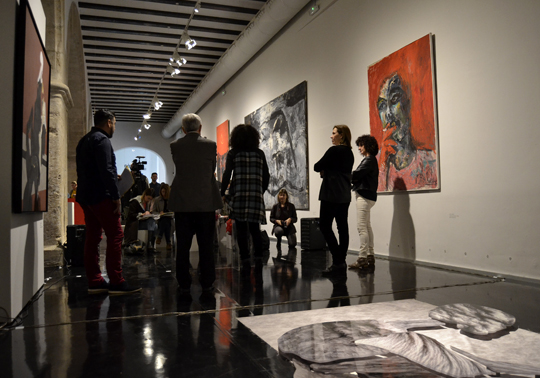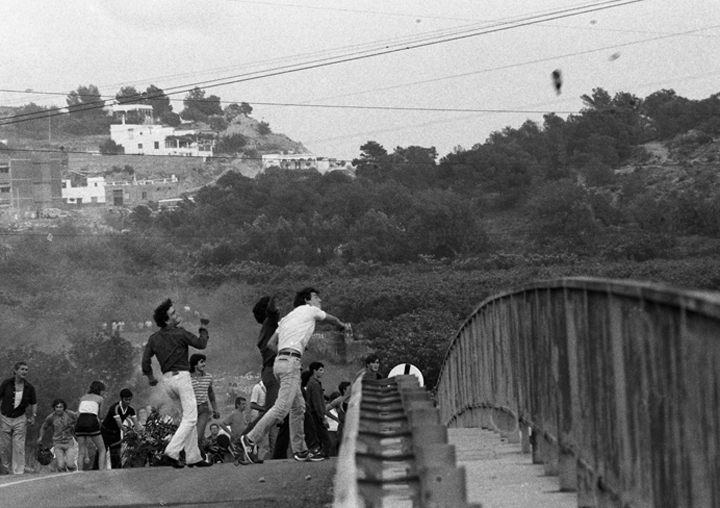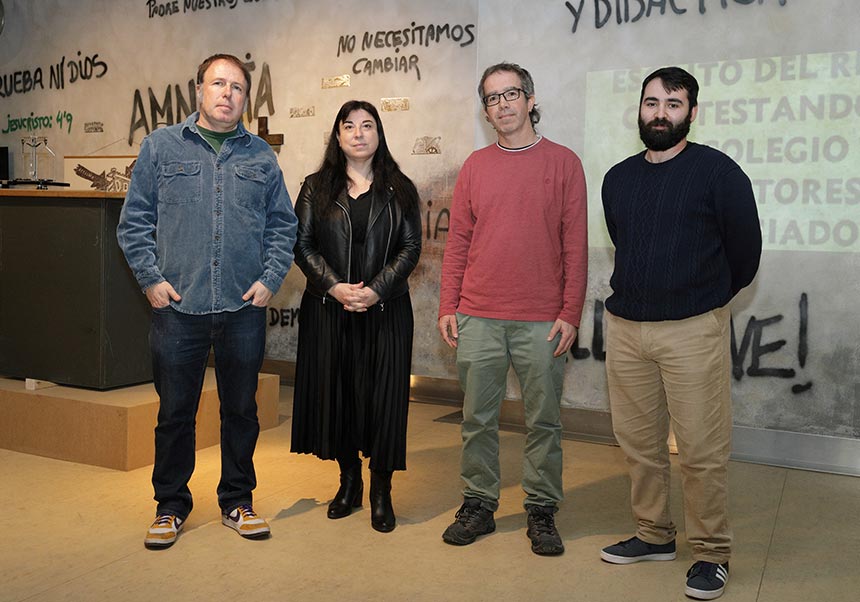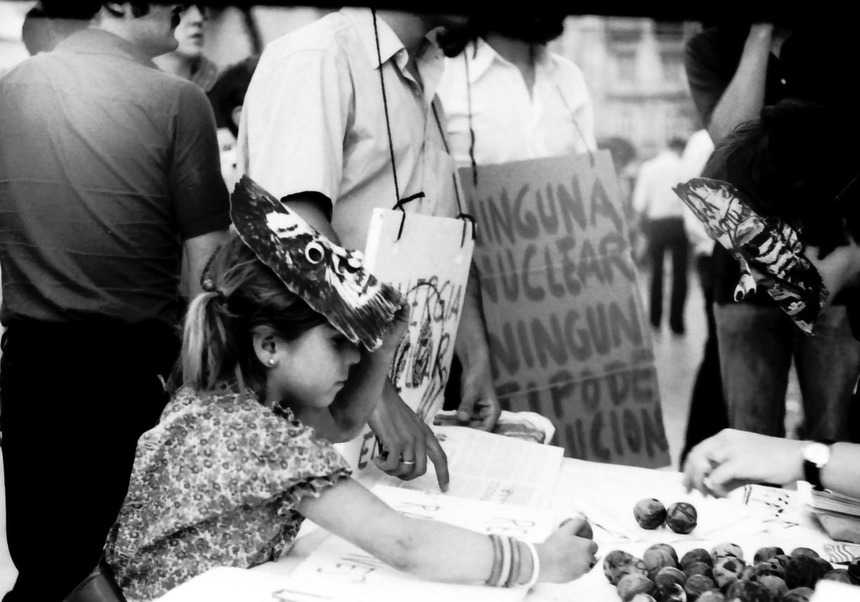“La Nau” celebrates its anniversary with three joint exhibitions
- Office of the Vice-Principal for Culture and Society
- March 6th, 2019

The cultural centre “La Nau” will inaugurate next Wednesday, on the 6th of March, at 8pm, three new exhibitions: ‘Idea. Imagen- Universidad Reloaded’, a large interactive installation of the ‘Laboratorio de Luz’ of the Universidad Politécnica de València to celebate the 50 anniversary of the university. ‘Lejos del canon. Veintitrés obras del museo de Vilafamés’ a colective exhibition about the five decades of the museum and “Self made woman”, a consideration about the body and the woman in the week of the International Women’s Day.
On Tuesday, the exhibitions were presented in the ‘Centre Cultural La Nau’ with the speeches of Antonio Ariño, vice-principal of Culture and Sports of the Universitat de València and the responsibles for the three exhibitions.
Through these expositive projects, the Universitat de València celebrates its 520 years and the twentieth anniversary of ‘La Nau’ as a cultural centre throughout the commemorations of other cultural institutions which also celebrate their years of activity in 2019:
50 años de la Universidad Politécnica de València y 50 años del Museu de Vilafamés.
Lluny del Cànon. 23 obres del Museu de Vilafamés. The museum of ‘Arte Contemporáneo Vicente Aguilera Cerní de Vilafamés’ was setttled down 50 years ago, eventhough the final opening of its halls was in 1972. It was the first museus of contemporary art funded in the Valencian Community and one of the former in Spain (behind the ‘Museo de Arte Contemporáneo’ of Madrid and the ‘Museo de Arte Abstracto’ de Cuenca. It was founded by Vicente Aguilera Cerni, one of the more international Spanish critics of art. He won Critics award ‘Biennale di Venezia’ in 1950. When he met Vilafamés, Aguilera made the ‘Diputació’ to buy a palace from the 15th century with the help of the then serving major Vicente Benet, with the aim to store a collection which was slowly created. After a while, he brought together a lot of artists with his idea, and some of them moved to Vilafamés.
Lluny del Cànon. 23 Obres del Museu de Vilafamés, a curated exhibition of Rosalía Torrent and José Miguel Molines for the ‘Sala Acadèmica’, an opportunity to show a part of its valuable and diverse artistic set and to enjoy some pieces that never before had been outside the artistic space of Vilafamés. In this occasion there are 23 artworks presented, many of the them with large dimensions and all of them with the distinctive feature of being in the atypical museum of Vilafamés. Artists such as Alberto Sánchez, Eusebio Sempere or Elena Asins are part of the exhibition that will be exhibited since the 5th of May.
Idea. Imatge-Universitat reloaded. Laboratorio de Luz is an interactive installation, a researcher groups from the Universitat Politècnica de València where some of the results from the current research of the ‘Laboratorio de Luz’ are shown. This expositive project which can be visited in the General Study Room until the 1st of May, is directed by Trinidad Gracia; Pepa L. Poquet, Amparo Carbonell and Emilio Martínez.
Idea. Imatge-Universitat reloaded. Laboratorio de Luz is an intervention which approaches issues regarding the construction and perception of image as a fragmentary process, disordered and non-linear closely linked to the context.
The central element is a cylindrical screen with a semi-panoramic projection of images which dialogue with the expositive space, the architecture, the history and the context in which the public plays an important role since with its presence or actions activates some mechanisms of the installation. The installation has as a main dispositive a cylindrical screen with 8 meters (26 feet) of diameter and 2,5 meters (6,5 feet) of height and it is suspended at 50 centimetres (1’5 feet) from the ground and opened 3 meters (10 feet) from one of its sides, which allows the visitor to get inside and visualise the projection from both parts of the screen, from outside and inside the structure.
The documentary recordings made for the exhibition in ‘La Nau’ approach three aspects which are present in the physic space of ‘La Nau’. The first it is about the architectural space of the building, placed in the former Jewish quarter of the city of Valencia. The recording is made by images obtained from the first cartographies of the city, especially from the map developed by father Tosca in 1704. Another of the audio-visual documentaries deals with the social contexts that the Universitat has witnessed, since the dictatorship until the end of the 70’s. And finally, the last documentary collects one of the most important patrimonies of the Universitat, its bibliographical collection, the library, the public place but also the place where some of the first books published in Valencia and Spain since the 15th century are located, as well as unique documents which collect the scientific activity since then to the present time.
Self Made Woman. Concha Ros. With the series ‘Self-made woman’ that can be visited at the Sala Oberta until the 1st of May, the artist Concha Ros anaylises her condition of women, of human being, revolving two axes: gender roles and personal growth, which are closely related. The author goes from the individual to the general in a project in which she appears drawing herself as a metaphor of the concept of ‘growing’ of ‘constructing herself’. The drawer affirms: ‘It is about to focus in a problem that not only affects me, but to everyone who ask themselves about their evolution and their interaction with the society in which we live in, and which have as an objective to contribute in the fight for the adoption of a more open and equal social model’. In the walls of the room four large drawings of two and a half meters are hung, illustrating four different types of women: the woman in construction, the divided woman, the kaleidoscopic woman and the woman in transition.
Together with the Concha Ros’ drawing, the animations of Miguel Vidal are projected. In the room, a monitor plays the making of the creative process of the exhibition, and a cabinet which contains a copy of the book by the artist Self Made Woman. All of this is completed with a game with spyholes that makes the viewer reflect about the concept of woman.
File in: Exposicions , Centre Cultural La Nau , Cultura
















